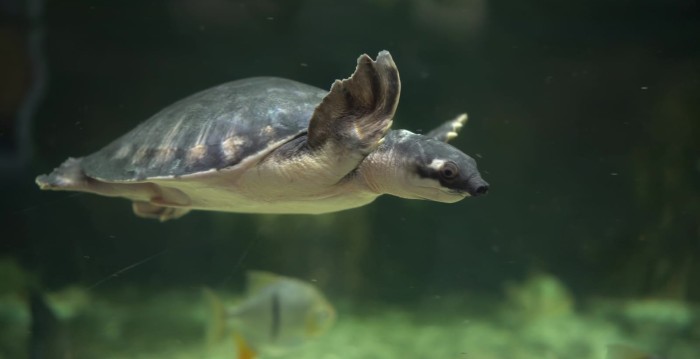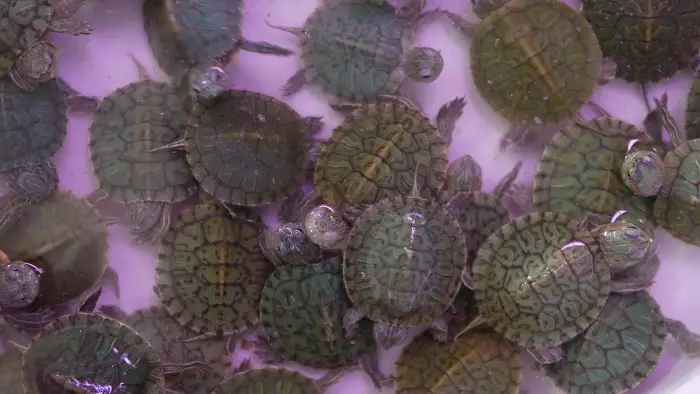If you live in the UK and wish to adopt a terrapin, you need to be careful as breeding and selling these adorable creatures is actually illegal in the country.
Unless you find a terrapin in the wild or are given one by an owner who can no longer look after it, you may accidentally become part of a terrapin trafficking ring.
If this surprises you, consider that poachers and illegal terrapin trading are endangering terrapins in their natural habitat from Massachusetts to Florida and Texas.
Terrapins are considered prized pets in many cultures (and a fine delicacy in Asia). As demand for terrapins increases, their numbers in the wild are slowly decreasing. This has led terrapins to be classified as vulnerable by the International Union for Conservation of Nature (IUCN) and in some places it is considered endangered.
But how does terrapin illegal trading work?
Poachers catch terrapins in their natural habitat and then ship them to places where they are in high demand. This illegal trade has multiple negative consequences, from decreased terrapin population to the degradation of the ecosystems where terrapins live.
Bearing in mind the origins of the latest COVID-19 pandemic, which is assumed to be bats and pangolins, there is also increased concern that terrapin trafficking could lead to another zoonotic disease passed from animal to human.
Where does terrapin trafficking come from?
The natural habitats for terrapins are estuaries and brackish waters from Massachusetts, along the Atlantic coast to the south, and across the Gulf of Mexico.
Most American states have stopped the legal trade of terrapins but there are still some states like Louisiana where commercial terrapin trapping is legal.
Terrapins have beautiful shells with attractive diamond patterns and are in high demand for their looks. They also make relatively fuss-free pets and can live long lives, which adds to their value.
Where do trafficked terrapins end up?
Most terrapins that are trapped and captured are sold to buyers, usually in Asia, who value these animals—either as pets or food.
The high prices and overall value buyers place on terrapins, makes the illegal trading networks worthwhile. It is estimated that between 1998 and 2021 at least 24,000 freshwater turtles of 34 different species were traded, with trade occurring in at least 43 U.S. states. It is highly likely that the real numbers are much higher and that many trafficking networks operate as yet undiscovered.
These findings are supported by a covert operation by the Wildlife Justice Commission. This unfolded between 2016 and 2018 and aimed at uncovering terrapin trafficking networks and putting poachers and buyers behind bars.
Why is terrapin trafficking a concern?
When we hear of wildlife trafficking, we typically think of rhinos, elephants, tigers, and other animals. Yet terrapins are prized animals that still attract poachers and traffickers.
The most obvious problem with trafficking is that terrapin numbers are decreasing. Demand for terrapins—whether as pets or as a delicacy—is increasing faster than the reproduction speed of terrapins.
Only about 1% to 3% of terrapin hatchlings make it to adulthood.
Terrapins can live up to 30 or 40 years and reach sexual maturity when they are eight years old, unlike other animals that can reproduce relatively younger. This slow reproductive process means it can take years for the terrapin population to rebuild itself.
Another concern is that traffickers catch adult terrapins, which are the ones that have managed to reach adulthood and are ready to reproduce.
Because of terrapins’ natural reproduction cycle and the increased trafficking, there has been a steady decline in terrapin populations across the world.
How does the terrapin population decline affect their natural habitats?
As with any animal that becomes vulnerable or endangered, there is an ecological imbalance in the estuaries where terrapins live. The ecosystem is disrupted, which has chain effects on the natural habitat itself.
Aside from the obvious endangerment of an animal species and the loss to local fauna, terrapins also protect marshes and estuaries.
Brackish coastal areas are teeming with crabs and snails. These animals eat plants and herbs that hold the marshes and soil together. By eating these crabs and snails, terrapins help creeks and waterways maintain their structure.
With rising sea water levels and more destructive hurricanes, marshes and estuaries are already in danger. Marshes and mangroves are crucial in the fight against rising sea levels and protect inland areas from flooding during storms and hurricanes.
Terrapins are helping maintain these fragile ecosystems. As we lose terrapin populations, coastal areas are more threatened and prone to destruction.

Are there any other concerns about terrapin trafficking?
The latest pandemic showed that there are serious health risks when wild animals interact closely with humans.
The bird flu, swine flu, and COVID-19 are examples of zoonoses, which means they were originally passed from wild animals to humans.
The havoc such diseases have wreaked on humanity is immense, so there is an increasing agreement that wildlife should be kept away from close contact with humans.
Of course, it’s highly unlikely that terrapins carry any threatening disease to humans and many British households have terrapins as pets and are enjoying their company.
However, terrapins can still become hosts to other diseases because poachers keep terrapins and other wild animals together under terrible sanitary conditions until they are sold.
Close proximity, bad hygiene, and minimal veterinary supervision can quickly turn into another zoonotic pandemic.
Terrapins are vital to the environment
While small in size, terrapins are unique and precious creatures. They are amongst the very few animals that live in brackish waters, where saltwater meets fresh water. They are also crucial to the health and survival of marshes and mangroves.
Their reproduction rate is not keeping pace with the speed at which poachers remove them from their natural habitat.
Terrapins are also endangered because of climate change, loss of food sources, and human encroachment on their habitat.
Ecosystems are very important and should be kept in balance. Wild animals deserve to be protected and terrapins are already vulnerable as their populations dwindle.
Terrapins in the UK
The case of terrapins in Britain is a unique one.
Britain has declared terrapins an invasive species because terrapins in the wild have been detected in ponds and lakes. British weather and land conditions are far different from terrapin natural habitats. There is concern that terrapins could unbalance local ecosystems just as there is concern that poachers are threatening the ecosystems where terrapins come from.
The vast majority of terrapin owners are conscientious with their duties towards their animals and their terrapin lead happy lives.
However, fragile ecosystems, climate change, and ecological concerns have come to the forefront of everyday life. And with the post-pandemic hindsight we have acquired, there is increasing concern about the proximity of wild animals to humans.
So, if you are looking to adopt a terrapin, please stay away from anyone promising to sell you a baby terrapin.
Breeding terrapins in Britain is illegal, so you may inadvertently become part of terrapin trafficking. Instead, look for owners who no longer wish to look after their terrapins or someone who has rescued a wild terrapin — possibly one that has been abandoned in the wild.
If you have decided to give a poor unwanted terrapin a good home, read first my complete terrapin guidebook, which you can download for FREE. In it, I cover everything you need to know about rescuing and looking after a pet terrapin.


